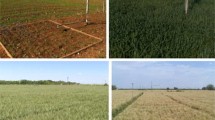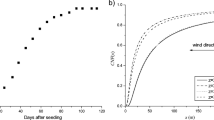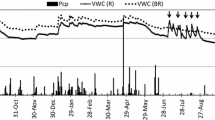Abstract
An accurate estimation of crop evapotranspiration (ET c) is very useful for appropriate water management; hence, an accurate and user-friendly model is needed to support related irrigation decisions. In this view, a study was developed aimed at estimating the ET c of winter wheat–summer maize crop sequence in the North China through eddy covariance measurements, to calibrate and validate the SIMDualKc model, to estimate the basal crop coefficients (K cb) for both crops and to partition ET c into soil evaporation and crop transpiration. Two years of field experimentation of that crop sequence were used to calibrate and validate the SIMDualKc model and to derive K cb using eddy covariance measurements. Various indicators have shown the goodness of fit of the model, with estimated values very close to the observed ones and estimate errors close to 0.5 mm d−1. The initial, mid-season and end basal crop coefficients for wheat were 0.25, 1.15 and 0.30, respectively, and those for maize were 0.15, 1.15 and 0.45, thus close to those proposed in FAO56 guidelines. The soil evaporation represented near 80 % of ET c for the initial stages of winter wheat and summer maize and decreased to only 5–6 % during the mid-season period. Evaporation during the full crop season averaged 28 % for winter wheat and 40 % for summer maize. The importance of wetting frequency and crop ground coverage in controlling soil evaporation was evidenced.




Similar content being viewed by others
References
Allen RG, Pereira LS (2009) Estimating crop coefficients from fraction of ground cover and height. Irrig Sci 28:17–34
Allen RG, Pereira LS, Raes D, Smith M (1998) Crop Evapotranspiration. Guidelines for Computing Crop Water Requirements. FAO Irrigation and Drainage Paper 56, FAO, Rome, Italy, 300 pp
Allen RG, Pereira LS, Smith M, Raes D, Wright JL (2005) FAO-56 dual crop coefficient method for estimating evaporation from soil and application extensions. J Irrig Drain Eng 131:2–13
Allen RG, Pereira LS, Howell TA, Jensen ME (2011) Evapotranspiration information reporting: I. Factors governing measurement accuracy. Agric Water Manag 98:899–920
Baldocchi DD (2003) Assessing the eddy covariance technique for evaluating carbon dioxide exchange rates of ecosystems: past, present and future. Glob Chang Biol 9:479–492
Brisson N, Mary B, Ripoche D, Jeuffroy MH, Ruget F, Gate P, Devienne F, Antonioletti R, Dürr C, Nicoullaud B, Richard G, Beaudoin N, Recous S, Tayot X, Plenet D, Cellier P, Machet JM, Meynard JM, Delécolle R (1998) STICS: a generic model for the simulation of crops and their water and nitrogen balance. I. Theory and parameterization applied to wheat and corn. Agronomie 18:311–346
Cai J, Liu Y, Xu D, Paredes P, Pereira LS (2009) Simulation of the soil water balance of wheat using daily weather forecast messages to estimate the reference evapotranspiration. Hydrol Earth Syst Sci 13:1045–1059
Cameira MR, Fernando RM, Ahuja LR, Ma L (2007) Using RZWQM to simulate the fate of nitrogen in field soil–crop environment in the Mediterranean region. Agric Water Manag 90:121–136
Ding R, Kang S, Li F, Zhang Y, Tong L, Sun Q (2010) Evaluating eddy covariance method by large-scale weighing lysimeter in a maize field of northwest China. Agric Water Manag 98:87–95
Eitzinger J, Trnka M, Hösch J, Žalud Z, Dubrovský M (2004) Comparison of CERES, WOFOST and SWAP models in simulating soil water content during growing season under different soil conditions. Ecol Modell 171:223–246
Eugster W, Mcfadden JP, Chapin ES (1997) A comparative approach to regional variation in surface fluxes using mobile eddy correlation towers. Bound Layer Meteor 85:293–307
Fandiño M, Cancela JJ, Rey BJ, Martínez EM, Rosa RG, Pereira LS (2012) Using the dual-Kc approach to model evapotranspiration of albariño vineyards (Vitis vinifera L. cv. albariño) with consideration of active ground cover. Agric Water Manag 112:75–87
Fang QX, Ma L, Green TR, Yu Q, Wang TD, Ahuja LR (2010) Water resources and water use efficiency in the North China Plain: current status and agronomic management options. Agric Water Manag 97:1102–1116
Franssen HJ, Stöckli R, Lehner I, Rotenberg E, Seneviratne SI (2010) Energy balance closure of eddy-covariance data: a multisite analysis for European FLUXNET stations. Agric For Meteorol 150(12):1553–1567
Gao Y, Duan A, Sun J, Li F, Liu Z, Liu H, Liu Z (2009) Crop coefficient and water-use efficiency of winter wheat/spring maize strip intercropping. Field Crops Res 111(1–2):65–73
Grassini P, Yang H, Cassman KG (2009) Limits to maize productivity in Western Corn-Belt: a simulation analysis for fully irrigated and rainfed conditions. Agric For Meteorol 149:1254–1265
Hsiao TC, Heng L, Steduto P, Rojas-Lara B, Raes D, Fereres E (2009) AquaCrop—the FAO crop model to simulate yield response to water: III. Parameterization and testing for maize. Agron J 101:448–459
Hsieh CI, Katul G, Chi T (2000) An approximate analytical model for footprint estimation of scaler fluxes in thermally stratified atmospheric flows. Adv Water Resour 23:765–772
Hunsaker DJ, Pinter PJ Jr, Kimball BA (2005) Wheat basal crop coefficients determined by normalized difference vegetation index. Irrig Sci 24:1–14
Kang S, Gu B, Du T, Zhang J (2003) Crop coefficient and ratio of transpiration to evapotranspiration of winter wheat and maize in a semi-humid region. Agric Water Manag 59(3):239–254
Khaledian MR, Mailhol JC, Ruelle P, Rosique P (2009) Adapting PILOTE model for water and yield management under direct seeding system: the case of corn and durum wheat in a Mediterranean context. Agric Water Manag 96:757–770
Lee X, Massman W, Law B (2010) Handbook of micrometeorology: a guide for surface flux measurement and analysis. Kluwer Academic Publishers, Dordrecht 250 pp
Legates DR, McCabe GJ (1999) Evaluating the use of ‘goodness-of-fit’ measures in hydrologic and hydroclimatic model validation. Water Resour Res 35:233–241
Lei H, Yang D, Shen Y, Liu Y, Zhang Y (2011) Simulation of evapotranspiration and carbon dioxide flux in the wheat-maize rotation croplands of the North China Plain using the Simple Biosphere Model. Hydrol Process 25:3107–3120
Li S, Kang S, Li F, Zhang L (2008) Evapotranspiration and crop coefficient of spring maize with plastic mulch using eddy covariance in northwest China. Agric Water Manag 95(11):1214–1222
Liu Y, Fernando RM (1998) Irrigation scheduling. In: Pereira LS, Musy A, Liang RJ, Hann M (eds) Water and soil management for sustainable agriculture in the north china plain. ISA, Lisbon, pp 167–235
Liu Y, Luo Y (2010) A consolidated evaluation of the FAO-56 dual crop coefficient approach using the lysimeter data in the North China Plain. Agric Water Manag 97:31–40
Liu Y, Pereira LS (2000) Validation of FAO methods for estimating crop coefficients. Trans CSAE 16(5):26–30
Liu Y, Pereira LS (2003) Optimization of irrigation scheduling considering the constraints of surface irrigation technology. Trans CSAE 19(4):74–79 (in Chinese)
Liu Y, Teixeira JL, Zhang HJ, Pereira LS (1998) Model validation and crop coefficients for irrigation scheduling in the North China Plain. Agric Water Manag 36:233–246
Liu C, Zhang X, Zhang Y (2002) Determination of daily evaporation and evapotranspiration of winter wheat and maize by large-scale weighing lysimeter and micro-lysimeter. Agric For Meteorol 111:109–120
Liu Y, Pereira LS, Fernando RM (2006) Fluxes through the bottom boundary of the root zone in silty soils: parametric approaches to estimate groundwater contribution and percolation. Agric Water Manag 84:27–40
Liu G, Liu Y, Cai J, Xu D (2011) Study on scale effect of farmland evapotranspiration and relationship with meteorological factors. J Hydraul Eng 42:284–289 (in Chinese)
Loague K, Green RF (1991) Statistical and graphical methods for evaluating solute transport models: overview and application. J Contam Hydrol 7:183–196
López-Urrea R, Montoro A, González-Piqueras J, López-Fuster P, Fereres E (2009) Water use of spring wheat to raise water productivity. Agric Water Manag 96:1305–1310
Mo X, Liu S, Lin Z (2012) Evaluation of an ecosystem model for a wheat-maize double cropping system over the North China Plain. Environ Modell Softw 32:61–73
Moore CJ (1986) Frequency response corrections for eddy correlation systems. Bound Layer Meteorol 37:17–35
Moriasi DN, Arnold JG, Van Liew MW, Bingner RL, Harmel RD, Veith TL (2007) Model evaluation guidelines for systematic quantification of accuracy in watershed simulations. Trans ASABE 50(3):885–900
Nash JE, Sutcliffe JV (1970) River flow forecasting through conceptual models: Part 1. A discussion of principles. J Hydrol 10(3):282–290
Paço TA, Ferreira MI, Rosa RD, Paredes P, Rodrigues GC, Conceição N, Pacheco CA, Pereira LS (2012) The dual crop coefficient approach using a density factor to simulate the evapotranspiration of a peach orchard: SIMDualKc model vs. eddy covariance measurements. Irrig Sci 30(2):115–126
Pereira LS, Cai LG, Hann MJ (2003) Farm water and soil management for improved water use in the North China Plain. Irrig Drain 52(4):299–317
Piccinni G, Ko J, Marek T, Howell T (2009) Determination of growth-stage-specific crop coefficients (Kc) of maize and sorghum. Agric Water Manag 96(12):1698–1704
Popova Z, Pereira LS (2011) Modelling for maize irrigation scheduling using long term experimental data from Plovdiv region, Bulgaria. Agr Water Manag 98(4):675–683
Ritchie JT (1972) Model for predicting evaporation from a row crop with incomplete cover. Water Resour Res 8:1204–1213
Rosa RD, Paredes P, Rodrigues GC, Alves I, Fernando RM, Pereira LS, Allen RG (2012a) Implementing the dual crop coefficient approach in interactive software. 1. Background and computational strategy. Agric Water Manag 103:8–24
Rosa RD, Paredes P, Rodrigues GC, Fernando RM, Alves I, Pereira LS, Allen RG (2012b) Implementing the dual crop coefficient approach in interactive software. 2. Model testing. Agric Water Manag 103:62–77
Sadras VO, Rodriguez D (2010) Modelling the nitrogen-driven trade-off between nitrogen utilisation efficiency and water use efficiency of wheat in eastern Australia. Field Crops Res 118:297–305
Savabi MR, Rawls WJ, Knight RW (1995) Water erosion prediction project (WEPP) rangeland hydrology component evaluation on a Texas range site. J Range Manag 48:535–541
Schotanus P, Nieuwstadt F, Debruin H (1983) Temperature-measurement with a sonic anemometer and its application to heat and moisture fluxes. Bound Layer Meteorol 26:81–93
Schuepp PH, Leclerc MY, MacPherson JI, Desjardins RL (1990) Footprint prediction of scalar fluxes from analytical solutions of the diffusion equation. Bound Layer Meteorol 50:355–373
Steduto P, Hsiao TC, Raes D, Fereres E (2009) AquaCrop—The FAO crop model to simulate yield response to water: I. Concepts and underlying principles. Agron J. 101:426–437
Sun H-Y, Liu C-M, Zhang X-Y, Shen Y-J, Zhang Y-Q (2006) Effects of irrigation on water balance, yield and WUE of winter wheat in the North China Plain. Agric Water Manag 85:211–218
Tahiri AZ, Anyoji H, Yasuda H (2006) Fixed and variable light extinction coefficients for estimating plant transpiration and soil evaporation under irrigated maize. Agric Water Manag 84:186–192
Todorovic M, Albrizio R, Zivotic L, Abi Saab M-T, Stöckle C, Steduto P (2009) Assessment of AquaCrop, CropSyst, and WOFOST models in the simulation of sunflower growth under different water regimes. Agron J 101:509–521
Twine TE, Kustas WP, Norman JM, Cook DR, Houser PR, Meyers TP, Prueger JH, Starks PJ, Wesely ML (2000) Correcting eddy-covariance flux underestimates over a grassland. Agric For Meteorol 103:279–300
Vickers D, Mahrt L (1997) Fetch limited drag coefficients. Bound Layer Meteorol 8:53–79
Wang Q, Watanabe M, Zhu O (2005) Simulation of water and carbon fluxes using BIOME-BGC model over crops in China. Agric For Meteorol 131:209–224
Wang J, Yu Q, Li J, Li L-H, Li X-G, Yu G-R, Sun X-M (2006) Simulation of diurnal variations of CO2, water and heat fluxes over winter wheat with a model coupled photosynthesis and transpiration. Agric For Meteorol 137:194–219
Wang J, Huang J, Rozelle S, Huang Q, Blanke A (2007) Agricultural and groundwater development in Northern China: trends, institutional response and policy options. Water Policy 9:61–74
Wang E, Yu Q, Wu D, Xia J (2008) Climate, agricultural production and hydrological balance in the North China Plain. Int J Climatol 28:1959–1970
Webb EK, Pearman GI, Leuning R (1980) Correction of flux measurements for density effects due to heat and water vapor. Q J R Meteorolog Soc 106:85–100
Wilczak JM, Oncley SP, Stage SA (2001) Sonic anemometer tilt correction algorithms. Bound Layer Meteorol 99:127–150
Willmott CJ (1981) On the validation of models. Phys Geog 2:184–194
Wohlfahrt G, Irschick C, Thalinger B, Hortnagl L, Obojes N, Hammerle A (2010) Insights from independent evapotranspiration estimates for closing the energy balance: a grassland case study. Vadose Zone J 9(4):1025–1033
Xu D, Mermoud A (2003) Modeling the soil water balance based on time-dependent hydraulic conductivity under different tillage practices. Agric Water Manag 63:139–151
Yu G-R, Wen X-F, Sun X-M, Tanner BD, Lee X, Chen J-Y (2006) Overview of ChinaFLUX and evaluation of its eddy covariance measurement. Agric For Meteorol 137:125–137
Yu LP, Huang GH, Liu HJ, Wang XP, Wang MQ (2009) Experimental investigation of soil evaporation and evapotranspiration of winter wheat under sprinkler irrigation. Agric Sci China 8(11):1360–1368
Zhang X, Pei D, Hu C (2003) Conserving groundwater for irrigation in the North China Plain. Irrig Sci 21(4):159–166
Zhang B, Kang S, Li F, Tong L, Du T (2010) Variation in vineyard evapotranspiration in an arid region of northwest China. Agric Water Manag 97(11):1898–1904
Zhang X, Chen S, Sun H, Shao L, Wang Y (2011a) Changes in evapotranspiration over irrigated winter wheat and maize in North China Plain over three decades. Agric Water Manag 6(98):1097–1104
Zhang Y, Shen Y, Sun H, Gates JB (2011b) Evapotranspiration and its partitioning in an irrigated winter wheat field: a combined isotopic and micrometeorologic approach. J Hydrol 408(3–4):203–211
Zhao C, Nan Z (2007) Estimating water needs of maize (Zea mays L.) using the dual crop coefficient method in the arid region of northwestern China. Afr J Agric Res 2(7):325–333
Zhao F-H, Yu G-R, Li S-G, Ren C-Y, Sun X-M, Mi N, Li J, Ouyang Z (2007) Canopy water use efficiency of winter wheat in the North China Plain. Agric Water Manag 93:99–108
Zhao NN, Liu Y, Cai JB, Rosa RD, Paredes P, Pereira LS (2013) Dual crop coefficient modelling applied to the winter wheat–summer maize crop sequence in North China Plain: basal crop coefficients and soil evaporation component. Agric Water Manag 117:93–105
Acknowledgments
The research grants from the Chinese National Natural Science Fund (51009151, and 50909098), National Key Basic Research Program (2006CB403405) and Special Scientific Fund sponsored by IWHR (1209) are acknowledged, as well as the support of the China-Portugal cooperative project funded by MOST, P. R. of China, and FCT, Portugal.
Author information
Authors and Affiliations
Corresponding author
Additional information
Communicated by S. Ortega-Farias.
Rights and permissions
About this article
Cite this article
Zhang, B., Liu, Y., Xu, D. et al. The dual crop coefficient approach to estimate and partitioning evapotranspiration of the winter wheat–summer maize crop sequence in North China Plain. Irrig Sci 31, 1303–1316 (2013). https://doi.org/10.1007/s00271-013-0405-1
Received:
Accepted:
Published:
Issue Date:
DOI: https://doi.org/10.1007/s00271-013-0405-1




